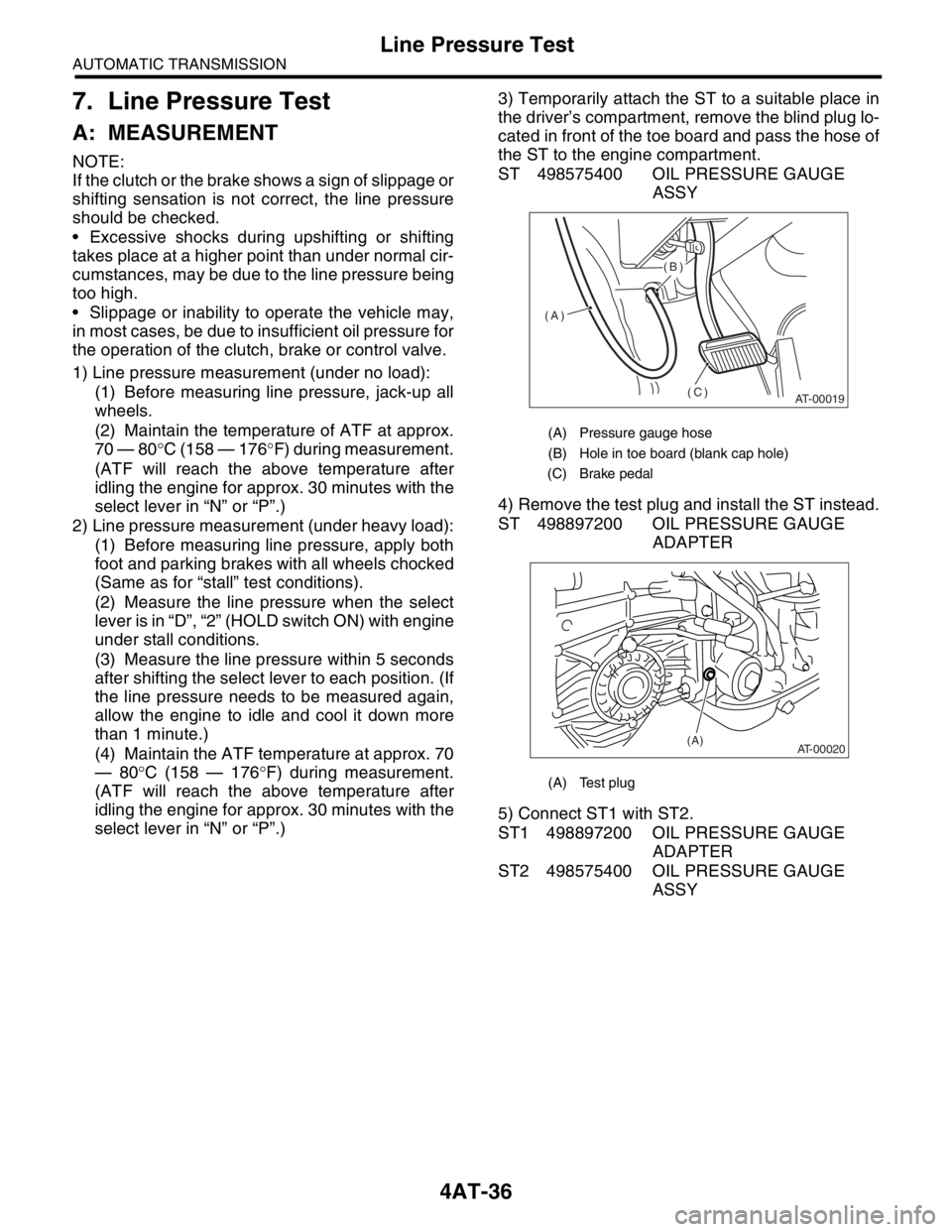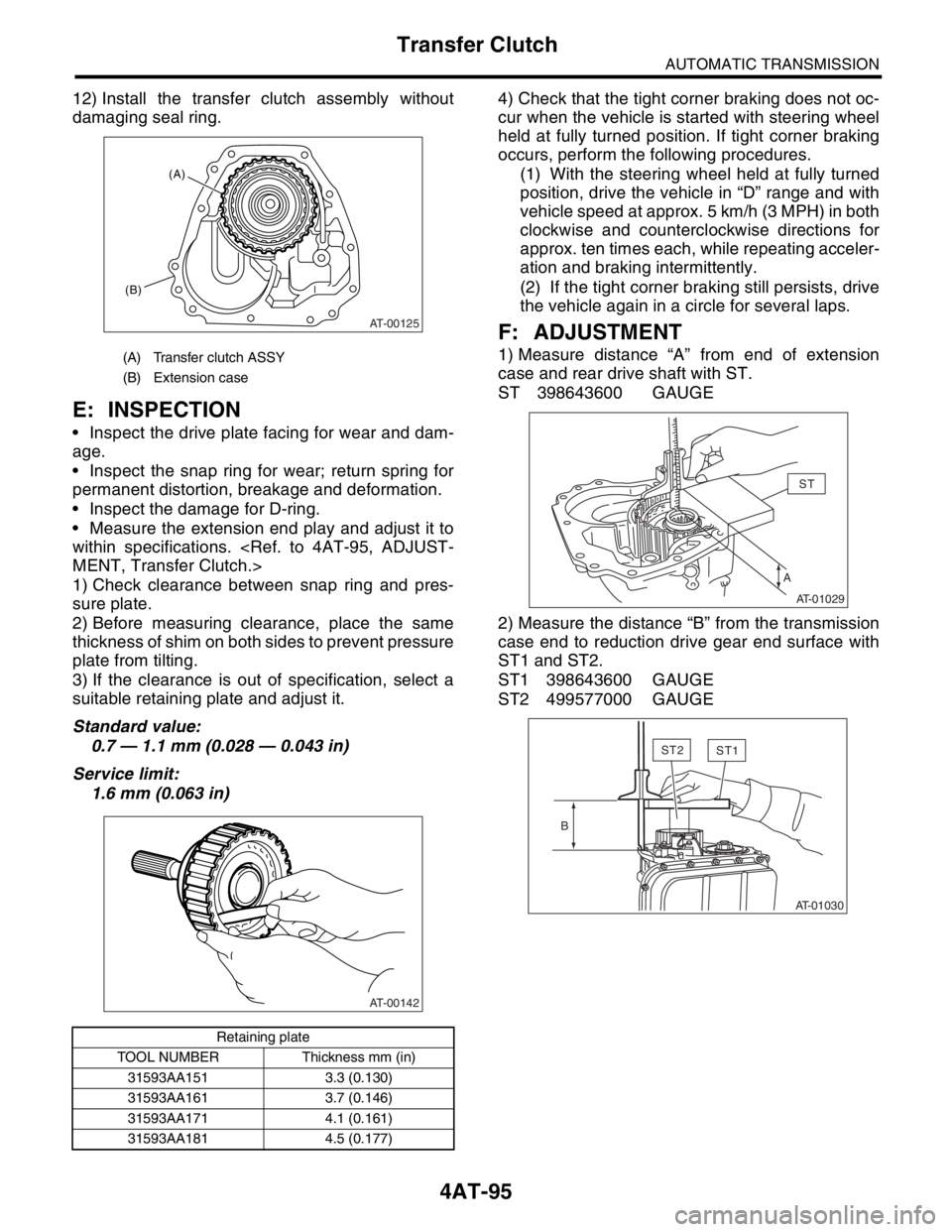2004 SUBARU FORESTER wheel
[x] Cancel search: wheelPage 2348 of 2870

4AT-36
AUTOMATIC TRANSMISSION
Line Pressure Test
7. Line Pressure Test
A: MEASUREMENT
NOTE:
If the clutch or the brake shows a sign of slippage or
shifting sensation is not correct, the line pressure
should be checked.
Excessive shocks during upshifting or shifting
takes place at a higher point than under normal cir-
cumstances, may be due to the line pressure being
too high.
Slippage or inability to operate the vehicle may,
in most cases, be due to insufficient oil pressure for
the operation of the clutch, brake or control valve.
1) Line pressure measurement (under no load):
(1) Before measuring line pressure, jack-up all
wheels.
(2) Maintain the temperature of ATF at approx.
70 — 80°C (158 — 176°F) during measurement.
(ATF will reach the above temperature after
idling the engine for approx. 30 minutes with the
select lever in “N” or “P”.)
2) Line pressure measurement (under heavy load):
(1) Before measuring line pressure, apply both
foot and parking brakes with all wheels chocked
(Same as for “stall” test conditions).
(2) Measure the line pressure when the select
lever is in “D”, “2” (HOLD switch ON) with engine
under stall conditions.
(3) Measure the line pressure within 5 seconds
after shifting the select lever to each position. (If
the line pressure needs to be measured again,
allow the engine to idle and cool it down more
than 1 minute.)
(4) Maintain the ATF temperature at approx. 70
— 80°C (158 — 176°F) during measurement.
(ATF will reach the above temperature after
idling the engine for approx. 30 minutes with the
select lever in “N” or “P”.)3) Temporarily attach the ST to a suitable place in
the driver’s compartment, remove the blind plug lo-
cated in front of the toe board and pass the hose of
the ST to the engine compartment.
ST 498575400 OIL PRESSURE GAUGE
ASSY
4) Remove the test plug and install the ST instead.
ST 498897200 OIL PRESSURE GAUGE
ADAPTER
5) Connect ST1 with ST2.
ST1 498897200 OIL PRESSURE GAUGE
ADAPTER
ST2 498575400 OIL PRESSURE GAUGE
ASSY
(A) Pressure gauge hose
(B) Hole in toe board (blank cap hole)
(C) Brake pedal
(A) Test plug
AT-00019
(A)(B)
(C)
AT-00020(A)
Page 2408 of 2870

4AT-95
AUTOMATIC TRANSMISSION
Transfer Clutch
12) Install the transfer clutch assembly without
damaging seal ring.
E: INSPECTION
Inspect the drive plate facing for wear and dam-
age.
Inspect the snap ring for wear; return spring for
permanent distortion, breakage and deformation.
Inspect the damage for D-ring.
Measure the extension end play and adjust it to
within specifications.
1) Check clearance between snap ring and pres-
sure plate.
2) Before measuring clearance, place the same
thickness of shim on both sides to prevent pressure
plate from tilting.
3) If the clearance is out of specification, select a
suitable retaining plate and adjust it.
Standard value:
0.7 — 1.1 mm (0.028 — 0.043 in)
Service limit:
1.6 mm (0.063 in)4) Check that the tight corner braking does not oc-
cur when the vehicle is started with steering wheel
held at fully turned position. If tight corner braking
occurs, perform the following procedures.
(1) With the steering wheel held at fully turned
position, drive the vehicle in “D” range and with
vehicle speed at approx. 5 km/h (3 MPH) in both
clockwise and counterclockwise directions for
approx. ten times each, while repeating acceler-
ation and braking intermittently.
(2) If the tight corner braking still persists, drive
the vehicle again in a circle for several laps.
F: ADJUSTMENT
1) Measure distance “A” from end of extension
case and rear drive shaft with ST.
ST 398643600 GAUGE
2) Measure the distance “B” from the transmission
case end to reduction drive gear end surface with
ST1 and ST2.
ST1 398643600 GAUGE
ST2 499577000 GAUGE(A) Transfer clutch ASSY
(B) Extension case
Retaining plate
TOOL NUMBER Thickness mm (in)
31593AA151 3.3 (0.130)
31593AA161 3.7 (0.146)
31593AA171 4.1 (0.161)
31593AA181 4.5 (0.177)
AT-00125
(A)
(B)
AT-00142
AST
AT-01029
ST2ST1
B
AT-01030
Page 2477 of 2870
![SUBARU FORESTER 2004 Service Repair Manual 4AT(H4SO)-18
AUTOMATIC TRANSMISSION (DIAGNOSTIC)
Subaru Select Monitor
2. READ CURRENT DATA
1) On the «Main Menu» display screen, select the {Each System Check} and press the [YES] key.
2) On the « SUBARU FORESTER 2004 Service Repair Manual 4AT(H4SO)-18
AUTOMATIC TRANSMISSION (DIAGNOSTIC)
Subaru Select Monitor
2. READ CURRENT DATA
1) On the «Main Menu» display screen, select the {Each System Check} and press the [YES] key.
2) On the «](/manual-img/17/57426/w960_57426-2476.png)
4AT(H4SO)-18
AUTOMATIC TRANSMISSION (DIAGNOSTIC)
Subaru Select Monitor
2. READ CURRENT DATA
1) On the «Main Menu» display screen, select the {Each System Check} and press the [YES] key.
2) On the «System Selection Menu» display screen, select the {Transmission Control System} and press the
[YES] key.
3) Press the [YES] key after the information of transmission type is displayed.
4) On the «Transmission Diagnosis» display screen, select the {Current Data Display & Save} and press the
[YES] key.
5) On the «Data Display Menu» display screen, select the {Data Display} and press the [YES] key.
6) Using the scroll key, move the display screen up or down until desired data is shown.
A list of the support data is shown in the following table.
NOTE:
For detailed operation procedure, refer to the SUBARU SELECT MONITOR OPERATION MANUAL.
Contents Display Unit of measure
Battery voltage Battery Voltage V
Rear vehicle speed sensor signal Rear Wheel Speed km/h or MPH
Front vehicle speed sensor signal Front Wheel Speed km/h or MPH
Engine speed signal Engine Speed rpm
Automatic transmission fluid temperature signal ATF Temp.°C or °F
Throttle position signal Throttle Sensor Voltage V
Gear position Gear Position —
Line pressure control duty ratio Line Pressure Duty Ratio %
Lock up clutch control duty ratio Lock Up Duty Ratio %
Transfer clutch control duty ratio (AWD model) Transfer Duty Ratio %
Power supply for throttle position sensor Throttle Sensor Power V
Torque converter turbine speed signal Turbine Revolution Speed rpm
2-4 brake timing pressure control duty ratio Brake Clutch Duty Ratio %
Intake manifold pressure sensor voltage Mani. Pressure Voltage V
FWD switch signal FWD Switch ON or OFF
Stop light switch signal Stop Light Switch ON or OFF
Anti lock brake system signal ABS Signal ON or OFF
Cruise control system signal Cruise Control Signal ON or OFF
Parking range signal P Range Signal ON or OFF
Neutral range signal N Range Signal ON or OFF
Reverse range signal R Range Signal ON or OFF
Drive range signal D Range Signal ON or OFF
3rd range signal 3rd Range Signal ON or OFF
2nd range signal 2nd Range Signal ON or OFF
1st range signal 1st Range Signal ON or OFF
Shift control solenoid A Shift Solenoid #1 ON or OFF
Shift control solenoid B Shift Solenoid #2 ON or OFF
Torque control output signal #1 Torque Control Signal 1 ON or OFF
Torque control output signal #2 Torque Control Signal 2 ON or OFF
Torque control cut signal Torque Control Cut Sig. ON or OFF
2-4 brake timing control solenoid valve 2-4 Brake Timing Sol. ON or OFF
Low clutch timing control solenoid valve Low Clutch Timing Sol. ON or OFF
Automatic transmission diagnosis indicator lamp Diagnosis Lamp ON or OFF
Power mode switch signal Power Mode Switch ON or OFF
Hold mode switch signal Hold Mode Switch ON or OFF
Kick down switch signal Kick Down Switch ON or OFF
Automatic transmission fluid temperature lamp ATF Temperature Lamp ON or OFF
Page 2506 of 2870

4AT(H4SO)-47
AUTOMATIC TRANSMISSION (DIAGNOSTIC)
Diagnostic Procedure with Diagnostic Trouble Code (DTC)
Step Check Yes No
1 CHECK HARNESS CONNECTOR BETWEEN
TCM AND TRANSMISSION.
1) Turn the ignition switch to OFF.
2) Disconnect the connector from TCM and
transmission.
3) Measure the resistance of harness
between TCM and transmission connector.
Connector & terminal
(B55) No. 18 — (B11) No. 17:Is the resistance less than 1
Ω?Go to step 2.Repair the open
circuit in harness
between TCM and
transmission con-
nector.
2 CHECK HARNESS CONNECTOR BETWEEN
TCM AND TRANSMISSION.
Measure the resistance of harness between
TCM and transmission connector.
Connector & terminal
(B54) No. 10 — (B11) No. 18:Is the resistance less than 1
Ω?Go to step 3.Repair the open
circuit in harness
between TCM and
transmission con-
nector, and poor
contact in cou-
pling connector.
3 CHECK HARNESS CONNECTOR BETWEEN
TCM AND TRANSMISSION.
Measure the resistance of harness between
TCM and chassis ground.
Connector & terminal
(B54) No. 10 — Chassis ground:Is the resistance more than 1
MΩ?Go to step 4.Repair the short
circuit in harness
between TCM and
transmission con-
nector.
4 CHECK HARNESS CONNECTOR BETWEEN
TCM AND TRANSMISSION.
Measure the resistance of harness between
TCM and chassis ground.
Connector & terminal
(B55) No. 18 — Chassis ground:Is the resistance more than 1
MΩ?Go to step 5.Repair the short
circuit in harness
between TCM and
transmission con-
nector, and poor
contact in cou-
pling connector.
5 CHECK FRONT VEHICLE SPEED SENSOR.
Measure the resistance between transmission
connector receptacle’s terminals.
Connector & terminal
(T4) No. 17 — No. 18:Is the resistance 450 — 650
Ω?Go to step 6.Replace the front
vehicle speed sen-
sor.
Speed Sensor.>
6 PREPARE OSCILLOSCOPE.Do you have an oscilloscope? Go to step 9.Go to step 7.
7 PREPARE SUBARU SELECT MONITOR.Do you have a Subaru Select
Monitor?Go to step 10.Go to step 8.
8 CHECK INPUT SIGNAL FOR TCM.
1) Connect all connectors.
2) Lift-up or raise the vehicle and place rigid
rack.
NOTE:
Raise all wheels off floor.
3) Start the engine and set vehicle in 20 km/h
(12 MPH) condition.
NOTE:
The speed difference between front and rear
wheels may light the ABS warning light, but this
indicates no malfunction. When AT control diag-
nosis is finished, perform the ABS memory
clearance procedure of on-board diagnostics
system.
4) Measure the voltage between TCM con-
nector terminals.
Connector & terminal
(B55) No. 18 (+) — (B54) No. 10 (
−):Is the voltage more than AC 1
V?Even if the
POWER indicator
light was blinking,
the circuit has
returned to a nor-
mal condition at
this time. A tempo-
rary poor contact
or harness may be
the cause. Repair
the harness or
connector in the
front vehicle speed
sensor circuit.Go to step 11.
Page 2507 of 2870

4AT(H4SO)-48
AUTOMATIC TRANSMISSION (DIAGNOSTIC)
Diagnostic Procedure with Diagnostic Trouble Code (DTC)
9 CHECK FRONT VEHICLE SPEED SENSOR
USING OSCILLOSCOPE.
1) Connect all connectors.
2) Lift-up the vehicle and place rigid rack.
N
OTE:
Raise all wheels off ground.
3) Set the oscilloscope to TCM connector ter-
minals.
Connector & terminal
Positive probe; (B55) No. 18
Earth lead; (B54) No. 10
4) Start the engine, and drive the wheels
slowly.
N
OTE:
The speed difference between front and rear
wheels may light the ABS warning light, but this
indicates no malfunctions. When AT control di-
agnosis is finished, perform the ABS memory
clearance procedure of self-diagnosis system.
5) Measure the signal voltage indicated on
oscilloscope.Is the voltage more than AC 4
V?Even if the
POWER indicator
light was blinking,
the circuit has
returned to a nor-
mal condition at
this time. A tempo-
rary poor contact
or harness may be
the cause. Repair
the harness or
connector in front
vehicle speed sen-
sor circuit.Go to step 11.
10 CHECK INPUT SIGNAL FOR TCM USING
SUBARU SELECT MONITOR.
1) Connect all connectors.
2) Connect the Subaru Select Monitor to data
link connector.
3) Lift-up or raise the vehicle and place rigid
rack.
N
OTE:
Raise all wheels off floor.
4) Turn the ignition switch to ON and turn Sub-
aru Select Monitor switch to ON.
5) Start the engine.
6) Read the data of vehicle speed using Sub-
aru Select Monitor.
Compare the speedometer with Subaru
Select Monitor indications.
Vehicle speed is indicated in “km/h” or
“MPH”.
7) Slowly increase the vehicle speed to 60 km/
h (37 MPH).
N
OTE:
The speed difference between front and rear
wheels may light the ABS warning light, but this
indicates no malfunction. When AT control diag-
nosis is finished, perform the ABS memory
clearance procedure of on-board diagnostics
system.
tion increase as Subaru Select
Monitor data increases?Even if the
POWER indicator
light was blinking,
the circuit has
returned to a nor-
mal condition at
this time. A tempo-
rary poor connec-
tor or harness may
be the cause.
Repair the har-
ness or connector
in front vehicle
speed sensor cir-
cuit.Go to step 11.
11 CHECK POOR CONTACT.Is there poor contact in front
vehicle speed sensor circuit?Repair the poor
contact.Replace the TCM.
trol Module
(TCM).> Step Check Yes No
Page 2516 of 2870

4AT(H4SO)-57
AUTOMATIC TRANSMISSION (DIAGNOSTIC)
Diagnostic Procedure with Diagnostic Trouble Code (DTC)
2 CHECK HARNESS CONNECTOR BETWEEN
TCM AND TRANSMISSION.
Measure the resistance of harness between
TCM connector and chassis ground.
Connector & terminal
(B54) No. 22 — Chassis ground:Is the resistance more than 1
MΩ?Go to step 3.Repair the short
circuit in harness
between TCM and
transmission con-
nector.
3 CHECK SHIFT SOLENOID 1.
Measure the resistance between transmission
connector terminals.
Connector & terminal
(T4) No. 1 — No. 16:Is the resistance 10 — 16 Ω? Go to step 4.Go to step 7.
4 CHECK OUTPUT SIGNAL EMITTED FROM
TCM.
1) Connect the connectors to TCM and trans-
mission.
2) Turn the ignition switch to ON (engine
OFF).
3) Move the select lever to “D” range.
4) Measure the voltage between TCM con-
nector and chassis ground.
Connector & terminal
(B54) No. 22 (+) — Chassis ground (
−):Is the voltage more than 9 V? Go to step 5.Go to step 6.
5 CHECK OUTPUT SIGNAL EMITTED FROM
TCM.
1) Turn the HOLD mode switch to ON.
2) Measure the voltage between TCM con-
nector and chassis ground.
Connector & terminal
(B54) No. 22 (+) — Chassis ground (
−):Is the voltage less than 1 V? Even if the
POWER indicator
light was blinking,
the circuit has
returned to a nor-
mal condition at
this time. A tempo-
rary poor contact
of the connector or
harness may be
the cause. Repair
the harness or
contact in TCM.Go to step 6.
6 CHECK POOR CONTACT.Is there poor contact in shift
solenoid 1 circuit?Repair poor con-
tact.Replace the TCM.
trol Module
(TCM).>
7 CHECK SHIFT SOLENOID 1 (IN TRANSMIS-
SION).
1) Remove the transmission connector from
bracket.
2) Lift-up or raise the vehicle and support with
rigid rack.
NOTE:
Raise all wheels off ground.
3) Drain the ATF.
CAUTION:
Do not drain the ATF until it cools down.
4) Remove the oil pan, and disconnect con-
nector from shift solenoid 1.
5) Measure the resistance between shift sole-
noid 1 connector and transmission ground.
Te r m i n a l s
No. 1 — Transmission ground:Is the resistance 10 — 16 Ω? Go to step 8.Replace the shift
solenoid 1.
Solenoids, Duty
Solenoids and ATF
Temperature Sen-
sor.> Step Check Yes No
Page 2519 of 2870

4AT(H4SO)-60
AUTOMATIC TRANSMISSION (DIAGNOSTIC)
Diagnostic Procedure with Diagnostic Trouble Code (DTC)
Step Check Yes No
1 CHECK HARNESS CONNECTOR BETWEEN
TCM AND TRANSMISSION.
1) Turn the ignition switch to OFF.
2) Disconnect the connector from TCM and
transmission.
3) Measure the resistance of harness
between TCM and shift solenoid 2 connector.
Connector & terminal
(B54) No. 5 — (B11) No. 2:Is the resistance less than 1
Ω?Go to step 2.Repair the open
circuit in harness
between TCM and
transmission con-
nector.
2 CHECK HARNESS CONNECTOR BETWEEN
TCM AND TRANSMISSION.
Measure the resistance of harness between
TCM connector and transmission ground.
Connector & terminal
(B54) No. 5 — Chassis ground:Is the resistance more than 1
MΩ?Go to step 3.Repair the short
circuit in harness
between TCM and
transmission con-
nector.
3 CHECK SHIFT SOLENOID 2.
Measure the resistance between transmission
connector terminals.
Connector & terminal
(T4) No. 2 — No. 16:Is the resistance 10 — 16 Ω? Go to step 4.Go to step 6.
4 CHECK OUTPUT SIGNAL EMITTED FROM
TCM.
1) Connect the connectors to TCM and trans-
mission.
2) Lift-up or raise the vehicle and support with
rigid rack.
N
OTE:
Raise all wheels off ground.
3) Start the engine and warm-up the transmis-
sion until ATF temperature is above 80°C
(176°F).
NOTE:
If ambient temperature is below 0°C (32°F),
drive the vehicle until ATF reaches its operating
temperature.
4) Move the selector lever to “D” range, and
slowly increase vehicle speed to 50 km/h (31
MPH).
NOTE:
The speed difference between front and rear
wheels may light the ABS warning light, but this
indicates no malfunction. When AT control diag-
nosis is finished, perform the ABS memory
clearance procedure of on-board diagnostics
system.
5) Measure the voltage between TCM con-
nector and chassis ground.
Connector & terminal
(B54) No. 5 (+) — Chassis ground (
−):Is the voltage less than 1 V? Even if the
POWER indicator
light was blinking,
the circuit has
returned to a nor-
mal condition at
this time. A tempo-
rary poor contact
of the connector or
harness may be
the cause. Repair
the harness or
connector in TCM
and transmission.Go to step 5.
5 CHECK POOR CONTACT.Is there poor contact in shift
solenoid 2 circuit?Repair the poor
contact.Replace the TCM.
trol Module
(TCM).>
Page 2523 of 2870

4AT(H4SO)-64
AUTOMATIC TRANSMISSION (DIAGNOSTIC)
Diagnostic Procedure with Diagnostic Trouble Code (DTC)
7 CHECK LOW CLUTCH TIMING SOLENOID
(IN TRANSMISSION).
1) Remove the transmission connector from
bracket.
2) Lift-up or raise the vehicle and support with
rigid rack.
N
OTE:
Raise all wheels off ground.
3) Drain the ATF.
CAUTION:
Do not drain the ATF until it cools down.
4) Remove the oil pan, and disconnect con-
nector from low clutch timing solenoid.
5) Measure the resistance between low clutch
timing solenoid connector and transmission
ground.
Te r m i n a l s
No. 1 — Transmission ground:Is the resistance 10 — 16 Ω? Go to step 8.Replace the low
clutch timing sole-
noid.
noids, Duty Sole-
noids and ATF
Temperature Sen-
sor.>
8 CHECK HARNESS CONNECTOR BETWEEN
LOW CLUTCH TIMING SOLENOID AND
TRANSMISSION.
Measure the resistance of harness between
low clutch timing solenoid and transmission
connector.
Connector & terminal
(AT9) No. 1 — (AT4) No. 3:Is the resistance less than 1
Ω?Go to step 9.Repair the open
circuit in harness
between low clutch
timing solenoid
and transmission
connector.
9 CHECK HARNESS CONNECTOR BETWEEN
LOW CLUTCH TIMING SOLENOID AND
TRANSMISSION.
Measure the resistance of harness between
low clutch timing solenoid connector and trans-
mission ground.
Connector & terminal
(T4) No. 3 — Transmission ground:Is the resistance more than 1
MΩ?Even if the
POWER indicator
light was blinking,
the circuit has
returned to a nor-
mal condition at
this time. A tempo-
rary poor contact
of the connector or
harness may be
the cause. Repair
the harness or
connector in low
clutch timing sole-
noid and transmis-
sion.Repair the short
circuit harness
between low clutch
timing solenoid
and transmission
connector. Step Check Yes No